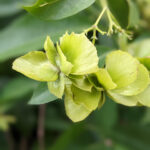Botanical Name: Rosmarinus officinalis
Family: Lamiaceae (Mint Family)
Ros = “dew” and marinus = “sea” officinalis essentially means that it is of the “officinarum” (medieval pharmacy) and has a history of medicinal usage
Common Names: Rosemary, Dew of the Sea, Sea Dew, Elf Leaf, Guardrobe, Incensier, Compass Weed, and Polar Plant
Other Languages: French – Romarin, Spanish – Romero or Rosmarino, Italian – Romarino, German and Swedish – Rosmarin, Chinese – mi-tieh- hsiang, Arabic – iklil al-ajbal
Origin: Rosemary is native to the Mediterranean where it is more common in western and northern regions.
Other species: Rosmarinus officinalis is by far the chief member of its genus, but there are two other species: Rosmarinus eriocalyx and R. tomentosus. Both of these are restricted to southwestern Spain and northwestern Morocco.
Morphology: Rosemary, like other members of the mint family, has opposite leaves and “squarish” stems – but not as distinctly so as those of the genus Salvia. Its leaves are evergreen, linear, and have smooth edges that generally tend to curl slightly under the leaf blade. Because of the similarity in appearance to other evergreens, the leaves are often referred to as “needles.” The flowers are basically bilabiate, with a much larger lower lip. The lower lip is often marked with distinctive spots and lines and makes a great landing pad for bees – the flower’s pollinators. Two stamens curl up and under the upper lip (two conjoined petals) and then outward from the flower with the pistil similarly placed and between the stamens. The other two of the flower’s five petals stick out and down from the sides of the flower. The flowers tend to form in clusters at the leaf axils. Flower color is generally a shade of soft to medium blue or lavender-blue, but there are some varieties with white or pinkish flower coloration. In growth habit the plant can either be prostrate and sprawling or upright and shrubby, or somewhere in between. Generally the prostrate varieties tend to bloom much more than the upright varieties. Seeds are small nutlets and each flower can produce up to four seeds.
Attributes: Gender — male; planet — Sun; element — fire; zodiac sign — Leo; powers -– protection, love, lust, mental powers, exorcism, purification, healing, sleep, and youth.
History in Brief:
Rosemary has been found in the wrappings of Egyptian mummies.
Greek students believed that rosemary enhanced memory and brain function and thus they wore it in their hair and massaged its oil onto their foreheads when studying for exams.
The Romans adorned their household gods with rosemary and purified their flocks with its smoke.
In the France of the Medieval Ages, rosemary was often burned along with Juniper in hospitals to ward off contagion.
Folklore:
It is said that while Mary and Joseph were fleeing from Israel with the infant Jesus, Mary laid her blue cloak on a rosemary bush. Being so honored the flowers turned from white to blue.
Put a bowl of flour under a rosemary bush on Midsummer’s Eve (June 23rd). In the morning the initials of a future spouse will be traced in the flour.
Rosemary is said to attract fairies.
“Put the leaves [of rosemary] under thy bedde and thou shalt be delivered of evil dreams.”
-Banke’s Herbal, 1525
Language: In the Language of Flowers rosemary says “your presence revives me” and is a symbol of friendship, loyalty, and remembrance. Traditionally it is carried by brides in weddings and by mourners at funerals.
“Grow it for two ends, it matters not at all, Be’t for my bridal or my burial.”
-Robert Herrick, 17th Century Poet
Literature: Rosemary has often been mentioned in writings of various forms. Here are a few: Lavender’s blue, dilly dilly, rosemary’s green,
When I am king, dilly, dilly, you shall be queen. Who told you so, dilly, dilly, who told you so?
‘Twas my own heart, dilly, dilly, that told me so.
-17th century children’s rhyme
Miss Ainslie gathered a bit of rosemary, crushing it between her white fingers. “See,” she said, “some of us are like that – it takes a blow to find the sweetness in our souls.”
-Lavender and Old Lace -Myrtle Reed (1874–1911) American Poet and Journalist
“Doth not rosemary and Romeo begin both with the same letters?”
-Romeo and Juliet
Interestingly, to my knowledge rosemary is not mentioned in any of the major books of religion. If you find any evidence to the contrary, please let me know.
Culinary Uses: There are virtually few areas of the culinary arts in which rosemary isn’t used. It is used in pestos, butters, oils, vinegars, cheeses, on the grill, in soups, in beverages, to season meats, in salt and dried herb blends, in the traditional bouquet garni, and in desserts and ice creams as well. Even the flowers can be used as a garnish or candied if one has the patience to deal with their small stature. All rosemary plants are edible (if grown organically), but different varieties have different essential oil contents and thus some are considered more “desirable” than others (and will be discussed later). For use in foods it is usually infused and later removed or chopped finely as the whole leaves can tough.
Medicinal Use: “Rosemary is an aromatic, restorative herb that relaxes spasms, relieves pain, and increases perspiration rate. It also stimulates the liver and gall bladder, improves digestion and circulation, and controls many pathogenic organisms. Rosemary is used internally for depression, apathy, nervous exhaustion, headaches and migraines associated with nervous tension or feeling cold, poor circulation and digestive problems associated with anxiety. It is used externally for rheumatism, arthritis, neuralgia, muscular injuries, wounds, dandruff, scurf, and hair loss.”
-From Encyclopedia of Herbs and Their Uses by Deni Bown
“Rosemary has antioxidant and antimutagenic properties which come from the content of phenolic diterpenes, particularly carnosic acid, carnosol, epirosmanol, and isorosmanol. Rosemary oil has been demonstrated to be antifungal, antibacterial, and antiviral. Researchers have found that the volatile oil of rosemary leaves may be useful in treating diabetes and dementia.”
– From The Big Book of Herbs by Thomas De Baggio and Arthur O. Tucker, Ph.D.
Warnings: The use of large quantities of rosemary in foods has been shown to increase menstrual flow in women and thus it is recommended that pregnant women limit, but not necessarily exclude, its consumption. Large amounts may also irritate the kidneys and stomach. As with most essential oils rosemary oils should not be consumed internally and should be diluted with carrier oils if used externally. Use of rosemary oil in aromatherapy has been shown to increase locomotor activity – which can be good or bad, depending upon the situation.
It is the policy of The Herb Society of America not to advise or recommend herbs for medicinal or health use. This information is intended for educational purposes only and should not be considered as a recommendation or an endorsement of any particular medical or health treatment.
Essential Oils: Rosemary contains a very large number of essential oils. The main oils are: alpha pinene, camphene, 1,8-cineole, camphor, bornyl acetate, and borneol. Spain, France, and Morocco supply most of the extracted essential oils on today’s market. Variance in plant variety, climate, and processing can produce oils that can vary greatly from one to the other.
Commercial Use: Commercially antioxidant chemicals are extracted from rosemary and are used for a variety of purposes. Here are a few: to prolong the freshness of poultry, stabilize and preserve pet foods, stabilize soy oils and potato chips, and also to stabilize many cosmetics.
Craft Use: Rosemary has a long tradition of use in crafts. In floral design it has been historically used in wedding and funeral arrangements and is often used to make wreaths and swags. It can be used in potpourri blends, dream pillows, as bookmarks to scent pages, in pinecones as fire starters, and can also be used to create a variety of natural dyes for fibers.
Culture:
Hardiness: Most in USDA zone 8, but some varieties hardy into zones 7 and 6.
Soil: Prefers a neutral to alkaline soil.
Light: Full sun is best, but it is tolerant of light shade.
Water: Moist, but well-drained; drought resistant once established.
Pruning: Depends upon variety – some don’t need it at all, some need only to be thinned, and some can be routinely pruned to form thicker shrubs. Never prune hard. Routinely remove dead wood.
Fertilize: Rarely – best to use organic or slow-release fertilizers.
Mulch: Use a thin layer or an inorganic mulch, such as pea gravel.
Container Culture: Plants will need routine watering and pruning, but be careful not to overwater. Fertilize lightly and routinely or use slow-release fertilizers. Pot up when they get root bound or root-prune to control the size. They should not be kept indoors for prolonged periods. They make wonderful topiary and bonsai specimens.
Pests: Rosemary is normally not prone to having pest problems, but it can happen. Look out for spider mites, mealy bugs, caterpillars, leaf hoppers, whiteflies, and thrips. Rosemary is very deer resistant! Even more problematic than insect pests are bacterial and fungal root pathogens. Rosemary prefers a lean, well-drained soil and is often attacked by root pathogens if it has poor drainage and/or is kept too wet. If you have poor drainage, then raise the planting or grow in containers. Powdery mildew (a fungus) can also be a problem on some varieties if they don’t get enough sun or air circulation.
Propagation: Rosemary can either be propagated by seed or by cuttings. Seeds are small, hard to collect, and tend to be slow and erratic in germination and named cultivars will not remain true to type if propagated this way. The preferred method of propagation is by tip cuttings. They can be rooted in a variety of soilless mixes (potting soil) if they are well-drained and can also be rooted in water. I find that rooting hormones are not necessary and if you do use them I would recommend ones with weaker hormone concentrations. Tip layering is an alternative propagation method that allows you to propagate new plants in the ground around a mother plant while the stems remain attached. It is a bit slower but very reliable and easy if you just want to propagate a few new plants and don’t want to deal with maintaining the proper environment for cuttings.
Varieties: There are hundreds of varieties available in the US and around the world. Some are highly distinct, some are not, and in quite a few cases a variety may go by different names in different places.
Best Culinary Varieties: As mentioned previously the essential oil makeup of rosemary varieties will influence their aroma and taste. While all rosemary varieties are edible, some are considered more “desirable” because they have less pine and camphor oils and thus taste less “medicinal.” These are: ‘Arp’, ‘Madalene Hill’ (aka ‘Hill Hardy’), ‘Tuscan Blue’, ‘Salem’, ‘Gorizia’, and ‘Spice Islands’.
Most Cold Hardy: ‘Arp’ is noted as the most cold hardy of all and is known to survive in some areas of zone 6. ‘Hill Hardy’ and ‘Salem’ are also notable for their cold hardiness.
Other Varieties of Note: There are many wonderful varieties to choose from and here are just a few: Upright: ‘Joyce DeBaggio’ (aka ‘Golden Rain’) – golden edged leaves with rich purple flowers
‘Baby P.J.’ – small leaves and small stature – possibly the smallest variety
‘Wonderful’ – somewhat sprawling and a prolific bloomer with soft blue flowers
‘Benenden Blue’ – a dense grower good for topiary or hedging
‘Herb Cottage’ (aka ‘Foresteri’)- a good shrubby and very aromatic variety
Prostrate: ‘Blue Lady’- a large and prolific blooming variety
‘Haifa’- a very small and tidy plant good for a container or small space
‘Majorca Pink’- pink flowers and rangy, somewhat wild growth habit
‘Renzel’s’/ ‘Irene’- newer, notable variety with flowing habit and strong blooming habit
‘Santa Barbara’ – vigorous, spreading habit and lots of blooms
Landscape Uses: individual specimens, container plants, hedges, ground covers (high ones that you can’t walk on), and draping over walls (prostrate varieties of course).
“There’s rosemary, that’s for remembrance. Pray you, love, remember.” – Ophelia in Hamlet
Henry Flowers
January 2013









